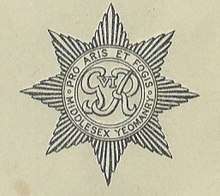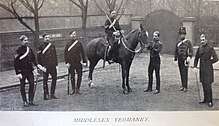Middlesex Yeomanry
| Middlesex Yeomanry | |
|---|---|
 Middlesex Yeomanry badge | |
| Active | 1797 – present |
| Country |
|
| Branch |
|
| Size |
Regiment (First World War and Second World War) Squadron (current) |
| Motto(s) | "Pro Aris et Focis" (For Hearth and Home) |
| Battle honours |
South Africa 1900-1901 The Great War 1914-1918 Macedonia 1916 -17 Gallipoli 1915 El Mughar Sharon Suvla Egypt 1915 -16 Nebi Samwil Damascus Scimitar Hill Gaza Megiddo Palestine 1917 - 18 |
The Middlesex Yeomanry was a volunteer cavalry regiment originally raised in 1797. It saw action in the Second Boer War, in the First World War and in the Second World War. Its lineage is maintained by 31 (Middlesex Yeomanry and Princess Louise's Kensington) Signal Squadron, Royal Corps of Signals which forms part of the Army Reserve.
History
Formation and early history
In 1793 the Prime Minister, William Pitt the Younger, proposed that the English Counties form a force of Volunteer Yeoman Cavalry that could be called on by the King to defend the country against invasion or by the Lord Lieutenant to subdue any civil disorder within the country.[1] A cavalry troop entitled the Uxbridge Volunteer Cavalry was raised by Christopher Baynes (later Sir Christopher Baynes) in 1797.[2] After the Treaty of Amiens was concluded in 1802 the regiment was disbanded[3] but, following a spate of industrial unrest and rioting, it was raised again as the Uxbridge Squadron of Yeomanry Cavalry with troops at Harefield and West Drayton, in 1830.[3] The regiment was called upon to provide an escort for King William IV as he passed through Uxbridge to visit the Marquess of Westminster at Moor Park in 1834.[4]

The regiment evolved to become the Middlesex Regiment of Yeomanry Cavalry (Uxbridge) in 1871 and, by order of Field Marshal the Duke of Cambridge, serving at that time as Commander-in-Chief of the Forces, the Middlesex (Duke of Cambridge's Hussars) Yeomanry Cavalry in 1884.[3]
Second Boer War
On 13 December 1899, the decision to allow volunteer forces serve in the Second Boer War was made. Due to the string of defeats during Black Week in December, 1899, the British government realized they were going to need more troops than just the regular army, thus issuing a Royal Warrant on 24 December 1899. This warrant officially created the Imperial Yeomanry.[5] The Royal Warrant asked standing Yeomanry regiments to provide service companies of approximately 115 men each. In addition to this, many British citizens (usually mid-upper class) volunteered to join the new regiment.[6] The Middlesex Yeomanry had raised three companies for service in South Africa by the end of January 1900.[4] These units fought against heavy odds at Senekal and Tweefontein.[7] The unit became the Middlesex Imperial Yeomanry (Duke of Cambridge's Hussars) in 1901 and the 1st County of London Yeomanry (Middlesex, Duke of Cambridge's Hussars) in 1908.[3] It moved to the Duke of York's Headquarters in 1912.[3]
First World War
| London Mounted Brigade |
|---|
|
Organisation on 4 August 1914 |
|
Assigned units
|
|
Training attachments
|
|
In accordance with the Territorial and Reserve Forces Act 1907 (7 Edw. 7, c.9) which brought the Territorial Force into being, the TF was intended to be a home defence force for service during wartime and members could not be compelled to serve outside the country. However, on the outbreak of war on 4 August 1914, many members volunteered for Imperial Service. Therefore, TF units were split in August and September 1914 into 1st Line (liable for overseas service) and 2nd Line (home service for those unable or unwilling to serve overseas) units. Later, a 3rd Line was formed to act as a reserve, providing trained replacements for the 1st and 2nd Line regiments.[8]
1/1st County of London Yeomanry
The 1st Battalion was mobilised in August 1914 and moved with the London Mounted Brigade to Hounslow before joining the 2nd Mounted Division at Streatley.[9] It moved to Egypt in April 1915 and to Gallipoli in August 1915.[9] It was evacuated from Gallipoli to Egypt in December 1915 and was deployed to Salonika in November 1916.[9]
During this campaign, Alexander Lafone was awarded the Victoria Cross for his actions at the Battle of Buqqar Ridge in October 1917.[10] Lieutenant Colonel Oliver Cyril Spencer Watson, another Middlesex Yeoman, was detached from the Regiment to the 2nd/5th Battalion, King's Own Yorkshire Light Infantry in 1917. He ultimately assumed command of this infantry Regiment and was awarded the Victoria Cross on 28 March 1918 at Rossignol Wood, north of Hebuterne, France. The Middlesex Yeomanry consequently lays claim to two of the three Victoria Crosses awarded to the Yeomanry as a whole.[11][12]
2/1st County of London Yeomanry
The 2nd Line regiment was formed at Chelsea in 1914 and in November 1914 it was at Ranelagh Park. By June 1915 it was with 2/1st London Mounted Brigade in 2/2nd Mounted Division and was at Bylaugh Park (north east of East Dereham) in Norfolk. In October it was at Blickling Hall.[13] On 31 March 1916, the remaining Mounted Brigades were ordered to be numbered in a single sequence;[14] the brigade was numbered as 12th Mounted Brigade and the division as 3rd Mounted Division.[13]
In July 1916, the regiment was converted to a cyclist unit in 4th Cyclist Brigade, 1st Cyclist Division in the North Walsham area. In November 1916, the division was broken up and regiment was merged with the 2/3rd County of London Yeomanry (Sharpshooters) to form 6th (1st and 3rd County of London) Yeomanry Cyclist Regiment in 2nd Cyclist Brigade, probably at Reepham. In March 1917 it resumed its identity as 2/1st County of London Yeomanry and moved to Overstrand; in the autumn it moved to Melton Constable. In May 1918 the regiment moved to Ireland and was stationed at The Curragh, still in 2nd Cyclist Brigade, until the end of the war.[13]
3/1st County of London Yeomanry
The 3rd Line regiment was formed in April 1915 at Ranelagh and in the summer it was affiliated to a Reserve Cavalry Regiment in Eastern Command. In the summer of 1916 it was affiliated to the 6th Reserve Cavalry Regiment at The Curragh. Early in 1917 it was absorbed into the 2nd Reserve Cavalry Regiment at The Curragh.[13]
Between the wars
After the war there was a reduction in the number of cavalry regiments and the Middlesex Yeomanry selected to re-role as the 2nd Cavalry Divisional Signals, Royal Signals (Middlesex Yeomanry).[3]
Second World War
The title of the regiment changed to Mobile Divisional Signals (Middlesex Yeomanry) in December 1938.[3] A second regiment was formed in 1939 and the title changed to 1st (Middlesex Yeomanry) Cavalry Divisional Signals.[3] It became the 9th Armoured Brigade Signal Squadron, Royal Signals (Middlesex Yeomanry) in 1941.[3] The brigade, together with its signal squadron, saw action at the Second Battle of El Alamein in October 1942 during the North African Campaign.[15]
Post war
The regiment was re-formed in 1947 and became the 16th Airborne Divisional Signals (Middlesex Yeomanry) and continued as such until the Airborne Division was reduced to a Parachute Brigade Group in 1956.[3] It was re-designated 40th Signal Regiment, Royal Signals (Middlesex Yeomanry) in 1959 and amalgamated with 47 (London) Signal Regiment to form 47th Signal Regiment, Royal Signals (Middlesex Yeomanry) in 1961.[3]
The unit was reduced to squadron status as 47th (Middlesex Yeomanry) Signal Squadron, part of 31st (Greater London) Signal Regiment, in 1967.[3] It was transferred to 39 (Skinners) Signal Regiment in 1995[3] and to 71 (Yeomanry) Signal Regiment in 2006.[4]
The squadron amalgamated with 41 Signal Squadron to form a new entity, 31 (Middlesex Yeomanry and Princess Louise's Kensington) Signal Squadron, in 2014.[16]
Uniforms
During its early decades the Middlesex Yeomanry wore Light Dragoon dress. In 1872 a hussar uniform was adopted but with dark green substituted for the blue of the regular cavalry regiments of that designation. The Middlesex Yeomanry disregarded War Office instructions to adopt silver braiding (the traditional distinction of volunteer units) and in a display of independence added additional gold braiding to their officers' tunics.[17] The photograph above shows the range of uniforms worn during the 1890s, with relatively plain service and ordinary duty dress the most commonly worn garments. As part of the newly organised Territorial Army from 1908, the regiment retained its unique green hussar uniforms (now worn with yellow striped blue breeches) including plumed busbies for review order.[18] The khaki service dress of the regular cavalry was adopted for training and ordinary duties about 1907, becoming the standard uniform worn on all occasions with the outbreak of World War I.[19]
See also
References
- ↑ "Worcestershire Yeomanry Cavalry (1794-1994)". Archived from the original on 15 August 2004.
- ↑ Redford and Riches 1818, p. 149
- 1 2 3 4 5 6 7 8 9 10 11 12 13 "1st County of London Yeomanry (Middlesex, Duke of Cambridge's Hussars) at regiments.org by T.F.Mills". Archived from the original on 15 July 2007. Retrieved 2 May 2015.
- 1 2 3 "An introduction to the Middlesex Yeomanry" (PDF). Royal Signals. Retrieved 4 November 2017.
- ↑ "Imperial Yeomanry". www.angloboerwar.com. Retrieved 28 March 2014.
- ↑ "Boer War Notes". www.roll-of-honour.com. Retrieved 28 March 2014.
- ↑ Charles Stonham & Benson Freeman, 1930. Historical Records of The Middlesex Yeomanry 1797-1927, Regimental Committee, Duke of York's Headquarters, London
- ↑ Rinaldi 2008, p. 35
- 1 2 3 Baker, Chris. "The 1st County of London Yeomanry". The Long, Long Trail. Retrieved 6 April 2015.
- ↑ "No. 30433". The London Gazette (Supplement). 14 December 1917. p. 13222.
- ↑ "No. 30675". The London Gazette (Supplement). 7 May 1918. p. 5555.
- ↑ "No. 31340". The London Gazette. 15 May 1919. p. 6085.
- 1 2 3 4 James 1978, p. 23
- ↑ James 1978, p. 36
- ↑ "Badge, formation, 9th Armoured Brigade & 9th Independent Armoured Brigade (TA)". Imperial War Museum. Retrieved 5 November 2017.
- ↑ "31 Signal Squadron". Ministry of Defence. Retrieved 5 November 2017.
- ↑ R.G. Harris, plate 13, "50 Years of Yeomanry Uniforms" Frederick Muller Ltd, London 1972
- ↑ Smith, R.J. The Yeomanry Force at the 1911 Coronation. p. 19. ISBN 0-948251-26-3.
- ↑ "Uniforms of the British Yeomanry Regiments". Retrieved 19 January 2018.
Bibliography
- James, Brigadier E.A. (1978). British Regiments 1914–18. London: Samson Books Limited. ISBN 0-906304-03-2.
- Mileham, Patrick (1994). The Yeomanry Regiments; 200 Years of Tradition. Edinburgh: Canongate Academic. ISBN 1-898410-36-4.
- Redford, George; Riches, Thomas (1818). The history of the ancient town and borough of Uxbridge: containing copies of intereseting documents. William Lake.
- Rinaldi, Richard A (2008). Order of Battle of the British Army 1914. Ravi Rikhye. ISBN 978-0-97760728-0.
- Stonham, Charles & Freeman, Benson, (1930). Historical Records of The Middlesex Yeomanry 1797-1927, Regimental Committee, Duke of York's Headquarters, London
External links
- Baker, Chris. "The 1st County of London Yeomanry". The Long, Long Trail. Retrieved 6 April 2015.
- 1st County of London Yeomanry (Middlesex, Duke of Cambridge's Hussars) at regiments.org by T.F.Mills at the Wayback Machine (archived 15 July 2007)
- "1 County of London Yeomanry (Middlesex, Duke of Cambridge's Hussars)". Orders of Battle.com.